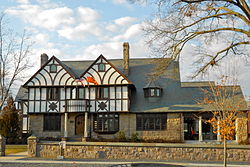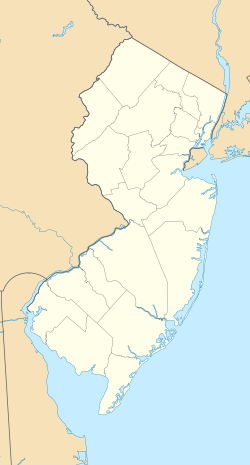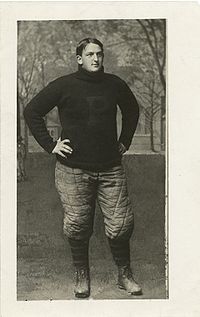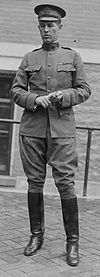
Princeton University is a private Ivy League research university in Princeton, New Jersey. Founded in 1746 in Elizabeth as the College of New Jersey, Princeton is the fourth-oldest institution of higher education in the United States and one of the nine colonial colleges chartered before the American Revolution. The institution moved to Newark in 1747, and then to its current campus, nine years later. It officially became a university in 1896 and was subsequently renamed Princeton University.

The American Whig–Cliosophic Society, sometimes abbreviated as Whig-Clio, is a political, literary, and debating society at Princeton University and the oldest debate union in the United States. Its precursors, the American Whig Society and the Cliosophic Society, were founded at Princeton in 1769 and 1765 by James Madison, William Paterson, Oliver Ellsworth, and Aaron Burr.

Campus Club was one of the undergraduate eating clubs at Princeton University. Located on the corner of Washington Road and Prospect Avenue, Campus was founded in 1900. It was one of the eating clubs that abandoned the selective bicker process to choose members non-selectively, a status it held for over twenty years.

The Princeton Quadrangle Club, often abbreviated to "Quad", is one of the eleven eating clubs at Princeton University that remain open. Located at 33 Prospect Avenue, the club is currently "sign-in," meaning it permits any second semester sophomore, junior or senior to join. The club's tradition of openness is demonstrated as far back as 1970, when Quadrangle became one of the first coeducational eating clubs.
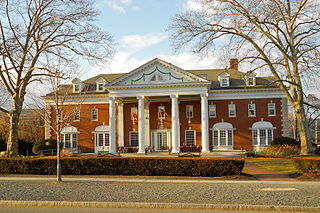
Colonial Club is one of the eleven current eating clubs of Princeton University in Princeton, New Jersey, United States. Founded in 1891, it is the fifth oldest of the clubs. It is located on 40 Prospect Avenue.

The Ivy Club, often simply Ivy, is the oldest eating club at Princeton University. It was founded in 1879 with Arthur Hawley Scribner as its first head.

Princeton Tower Club is one of the eleven eating clubs at Princeton University in Princeton, New Jersey, United States, and one of seven clubs to choose its members through a selective process called bicker. Tower is located at 13 Prospect Avenue between the university-run Campus Club and the Cannon Club; it currently has a membership of approximately 215.

The Princeton Charter Club is one of Princeton University's eleven active undergraduate eating clubs located on or near Prospect Avenue in Princeton, New Jersey, United States.

Princeton Terrace Club is one of eleven current eating clubs at Princeton University in Princeton, New Jersey, United States. Terrace Club was founded in 1904 and is located at 62 Washington Road. It is the sole Princeton eating club located off Prospect Avenue.

Cap and Gown Club, founded in 1890, is an eating club at Princeton University, in Princeton, New Jersey, United States. Colloquially known as "Cap", the club is one of the "Big Four" eating clubs at Princeton. Members are selected through a selective process called bicker. Sometimes known as "the Illustrious Cap and Gown Club," it was the first of the currently selective eating clubs to accept women. Though personalities of eating clubs certainly change throughout the years, Cap and Gown is described in F. Scott Fitzgerald's This Side of Paradise as "anti-alcoholic, faintly religious and politically powerful."

The University Cottage Club or simply Cottage Club is one of eleven current eating clubs at Princeton University, in Princeton, New Jersey, United States. It is one of the six bicker clubs, along with The Ivy Club, Tiger Inn, Cap and Gown Club, Cannon Club and Tower Club.
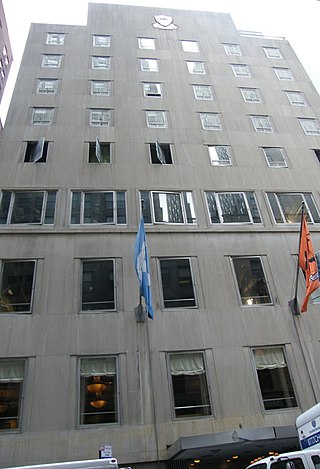
The Princeton Club of New York was a private clubhouse located at 15 West 43rd Street in Midtown Manhattan, New York City, New York, founded in 1866 as the Princeton Alumni Association of New York. It reorganized to its current name in 1886. Its membership was composed of alumni and faculty of Princeton University, as well as 15 other affiliated schools.

Edwin Mortimer Hopkins was an American university professor and college football coach. He served on the faculty at the University of Kansas from 1891 to 1937, where he was the head of the English department for many years. He was also the head coach for the school's football team for their 1891 season, their first official head coach. Hopkins graduated from Princeton University in 1888 with a bachelor's degree in English and earned a master's degree the following year. While at Princeton he was elected to the "Lit" board in 1888. That same year he won "The Lippincott prize" of $50 for writing the best article on "Social Life at Princeton". He returned to Princeton to complete his PhD in 1894, and upon his return to KU he became a full professor in English.

The eating clubs at Princeton University are private institutions resembling both dining halls and social houses, where the majority of Princeton undergraduate upperclassmen eat their meals. Each eating club occupies a large mansion on Prospect Avenue, one of the main roads that runs through the Princeton campus, with the exception of Terrace Club which is just around the corner on Washington Road. This area is known to students colloquially as "The Street". Princeton's eating clubs are the primary setting in F. Scott Fitzgerald's 1920 debut novel, This Side of Paradise, and the clubs appeared prominently in the 2004 novel The Rule of Four.

Cloister Inn is one of the undergraduate eating clubs at Princeton University in Princeton, New Jersey, United States.

The Princeton University Rugby Football Club is the college rugby team of Princeton University. The team currently competes in the Ivy Rugby Conference, an annual rugby union competition played among the eight member schools of the Ivy League.
Coeducation at Princeton University refers to the transition of Princeton University from being a single-sex education university which only admitted males to being a mixed-sex education university.
Ralph Tipton Davis was an American football player. He played college football at Princeton University and was a consensus All-American in 1901. He also played for Princeton's baseball and track teams. In 1902, he won the intercollegiate championship in the hammer throw and set a collegiate record with a throw of 164 feet, 10 inches.

Cannon Dial Elm Club, also known as Cannon Club, is one of the historic Eating Clubs at Princeton University. Founded in 1895, it completed its current clubhouse in 1910. The club closed in the early 1970s and later merged with Dial Lodge and Elm Club to form Dial, Elm, Cannon (DEC), which closed its doors in 1998. In 2011 DEC reopened, now bearing the name Cannon Dial Elm Club, using its historic clubhouse, which had served as the home for the Office of Population Research during the club's hiatus.
Sally Frank sued the three all-male eating clubs at Princeton University in 1978 for denying her on the basis of her gender. Over ten years later, in 1990 the eating clubs were defined as "public accommodation" and court ordered to become co-ed thanks to Sally Frank, her attorney Nadine Taub and the Women's Rights Litigation Clinic of Rutgers Law School. The eating clubs argued that they were completely private and separate from the university, giving them the right to sex discrimination. After many rounds in the courts, this argument eventually failed. The winning argument stated that the clubs were in fact not separate, and instead functioned as an arm of the university itself. This meant that the clubs were in the end covered by New Jersey's anti-discrimination law and forced to admit women.
